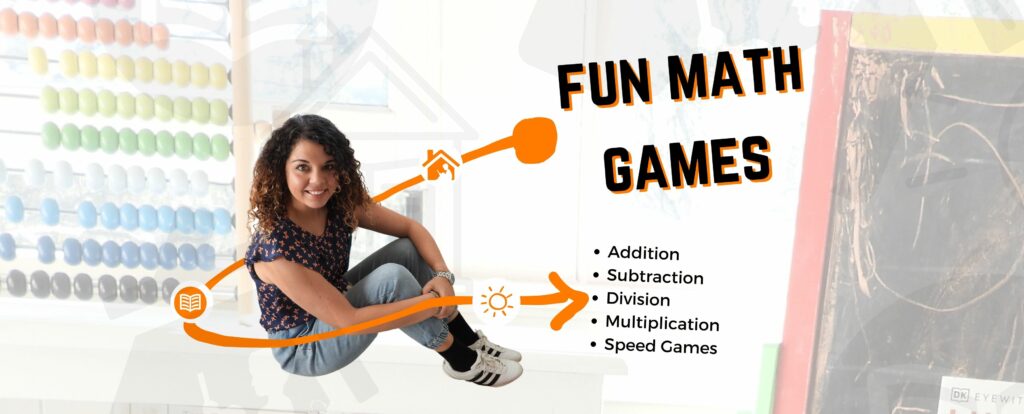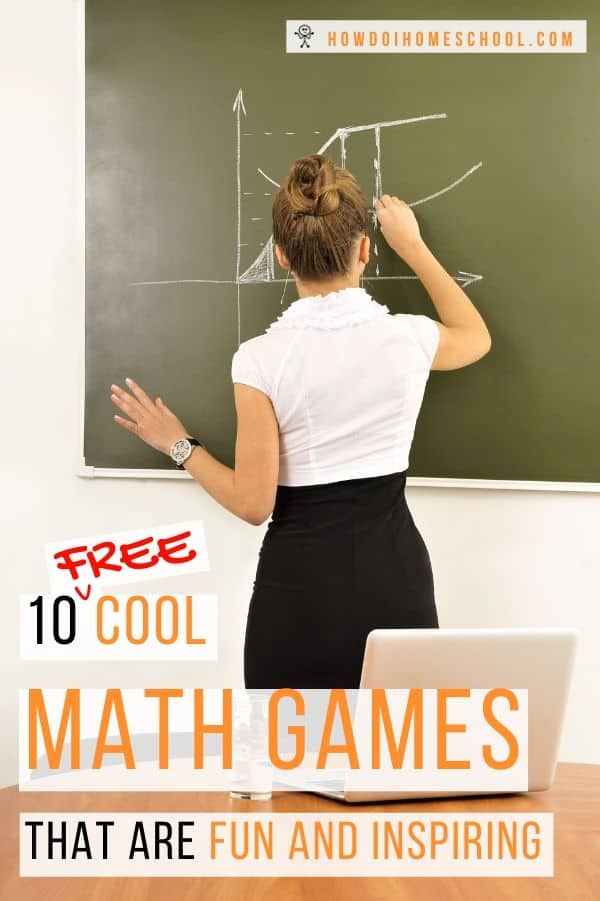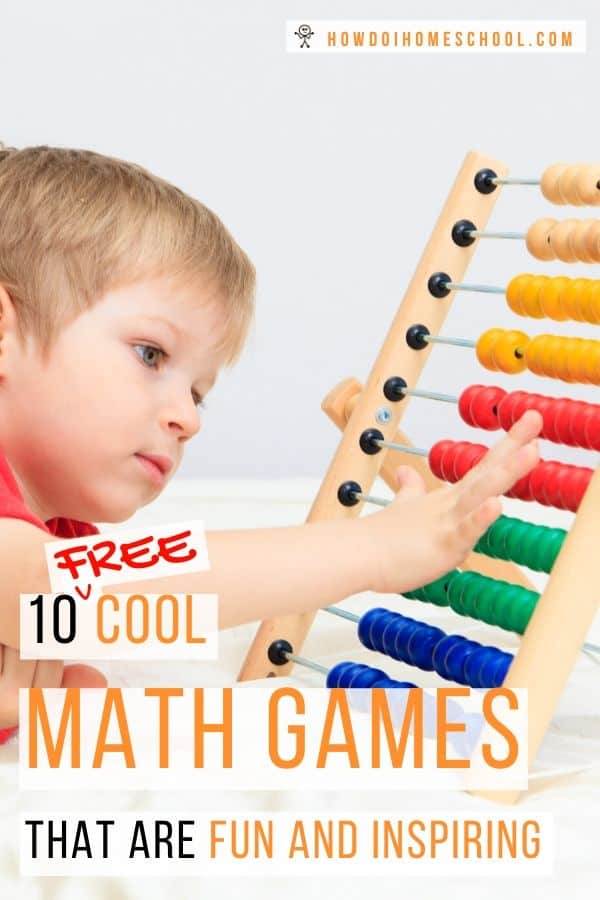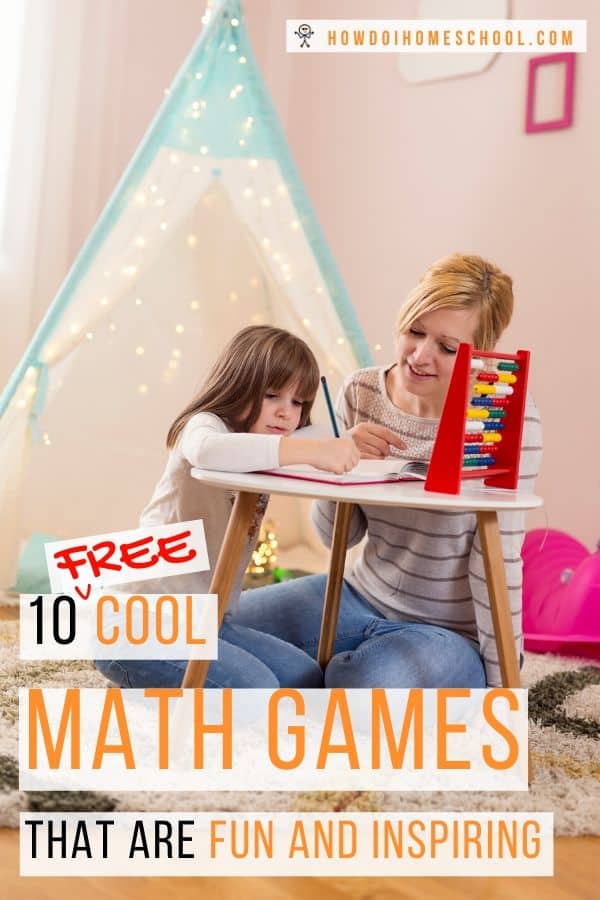Get ready to explore a world of exciting and entertaining math adventures with these cool math games! Say goodbye to the days of dull learning and hello to a new way of mastering addition, subtraction, multiplication, and division. Whether you’re at home or in school, these games are perfect for engaging your children in the world of numbers.

I hope you enjoy reading this blog post. If you want to do my course on how to homeschool, click here.
Forget the mind-numbing memorization of multiplication tables – let’s inject some fun into learning math!
Don’t worry; you won’t need to rely solely on screens for entertainment.
In this article, I’ve curated a fantastic collection of offline math games that will captivate your child’s interest.
They’ll soon be so excited they’ll be on social media with the hashtag #coolmathgame

Affiliate links are included in this article.
10+ Cool Math Games
Get ready to explore a bunch of cool math games!
This list includes outdoor, board, and indoor toys perfect for kids from kindergarten to high school. You can adjust them to fit any age group.
Some games are free, while others are worth buying (don’t forget you can get lots in thrift hauls from op shops for next to nothing like I did here).
These are the games we’ll explore in this post:
- Shops with American or Australian Fake Money!
- Number Recognition – Math Bingo
- Number Sorting – Suduko
- Addition, Subtraction, Multiplication & Division Game –Math Solitaire
- Addition and Subtraction Game – Math Tip
- Sharpen Math Skills Game – Quickest Wins
- Odds or Evens?
- Addition Game – Fun Finska
- Finding Numbers Game – Cool Math Scavenger Hunt
- Addition, Subtraction, Multiplication, Division, and Square Roots –Proof!
- Multiplication, Addition, and Subtraction Game – Math Dice
- Color, Number Recognition & Addition – Uno
- Number Recognition Math Game – Go Fish
Below I’ve included directions and tips for how to use them in your school or homeschool.

Affiliate links are used on this page.
Shop with Fake Money!
Shopping with fake money is a great activity for children in younger grade levels.
To play this game, get some fake money or if you’re confident the kids won’t lose the money, you can use real money in your wallet or purse.
Draw out labels with different cent and dollar amounts (for example, 1 cent, 5 cents, 50 cents, a dollar, $10, $100 etc) and slip these labels under thier favorite toys.
Get children to hold the bag of fake money and ask them to purchase what they want. Help them figure out the right amount.
You can also help them figure out if there is any change they need to work out.
After they’ve had a go at ‘being the customer’ let them have a go at being the shop keeper and you (or their sibling) can be the buyer.
Modifications for different ages
Initially, you can ask children to sort the same coins in the same piles while saying what coin it is. This helps them recognize the money.
For slightly older children, you can get children to add larger numbers in their heads and buy multiples of a product (which incorporates times tables). You can also get them to work out how much a product would be if there was a 10%, 20%, 75% discount. This is incredibly practical and will help them quickly get practical math skills.
Number Recognition – Math Bingo
The first math game on our list is Math Bingo. I discovered this gem when talking to a lovely homeschool mom.
She said her children loved math and believed it was because they taught with many fun math games. Their favorite one was Bingo – with a cool math twist.
To set up Math Bingo, you give your children a bingo card with a set of math problems in each square. The teacher holds a set of cards that have the answers to the problems on them.
The teacher then draws a card and calls out the sum. The student then has to solve the problems to find the correct problem that matches the answer.
They’ll have to solve several different math problems as they hunt for the right answer. When they find the right one, they can cross it out, color it in, or place a bingo marker on top.
The first student to fill in their card calls out, ‘Bingo’, and wins!
You can make the tokens and board pieces yourself or save yourself a lot of time and get one for addition and subtraction here and one for multiplication and division here. The first is for ages 5+; the second is for ages 9-13. They both accommodate 3 to 36 players so you can play it with many children in a classroom if you’re a teacher.
Modifications for different ages
To modify this game for different age groups, you simply have to change what types of math problems are on the bingo card.
Some good math concepts to practice with Math Bingo would be:
- addition
- subtraction
- multiplication
- division
- variable equations
- exponents
Any short math equations or problems that you can fit in the bingo square will work. Be sure to have some extra paper on hand for students to work out the problems if needed.
Number Sorting – Sudoku
Another classic game is Sudoku.
This game is a brilliant way for emergent mathematicians to enjoy learning their numbers while practicing problem-solving skills.
To complete a Sudoku, your child must place each number from 1-9 in every row, column, and 3×3 square only once. That means no number can be repeated in any row, column, or square.
You can play Sudoko for free by printing some free sudoku puzzles.
Or you can simply buy a sudoku book (this kid’s version is a great and educational present idea) to give to your students.
Modifications for different ages
For younger students, try using a smaller grid. Instead of the big sudoku puzzles with 9 different squares using numbers 1-9, try a small grid with 4 different squares using numbers 1-4.
As your child masters the 4×4 grid, you can move up to bigger grids.
Addition, Subtraction, Multiplication & Division Game – Math Solitaire
A really fun math game to play with kids is Math Solitaire. Solitaire is great for practicing addition, subtraction, multiplication, and division.
To play this game, you need to have an ordinary pack of playing cards. Place two cards in the middle of the table and give your students 3 cards which they can pick up when the educator says, ‘Go.’
Using the 2 original cards on the table, the students try to add, subtract, multiply, or divide the numbers to get an answer that matches one of their cards. If students can’t do this with the cards they’re holding, they each draw a card until they can make a match.
The first to do this wins the round! Play five rounds, and the person with the most round wins then wins the whole game.
Also, check out sites like Solitaired for a unique twist on classic solitaire! They offer various versions with an educational touch, featuring card decks about inspiring inventors, heroes of the Civil Rights movement, and even a history of K-pop for the younger audience.
Modifications for different ages
To modify Solitaire for different ages, you can switch up what type of math the children need to do to make a match.
For younger students, have them add or subtract the two cards in the middle. For older students, have them multiply or divide the two cards in the middle.
Addition & Subtraction Game – Math Tip
If you don’t want to be stuck indoors the whole day, check out this active fun math game I like to call ‘Math Tip.’
The aim of this game is to learn addition and subtraction while getting outdoors and doing a little exercise together! Hopefully, nerds and jocks alike will enjoy this one!
In Math Tip, children have numbers attached to their body (wrist, back, or chest), and you have 10 chairs with the numbers 1-10 written on them.
The teacher calls ‘Add’ or ‘Subtract,’ and then the students need to find other students with the appropriate number before going together to the correctly numbered station.
For example, if a teacher says, ‘Subtract,’ a student with the number 9 on their wrist finds another student with a 6 and then runs to the appropriate station, which would be a 3.
If the teacher says, ‘Add,’ a student with a 2 might find a student with a 3 and then run to the station marked 5.
The remainder of the students can help the other students by calling out so as many students as possible can get to a station. In this way, it is collaborative rather than competitive.
Modifications for different ages
To modify this game for different ages, you can switch up what type of math the children need to do to make a match. For younger students have them add or subtract before finding their station. For older students have them multiply or divide before finding their station.
Or you could change how many children need to pair up to make their number. So instead of 2 students adding together to make 15, make it 3 students.
Sharpen Math Skills Game – The Quickest Wins
The Quickest Wins is a crazy fun math game that helps students sharpen their math skills.
It’s a two-player activity that students can play with their teachers or parents if they’re homeschooled.
The game aims to sharpen your math skills and make you super quick at coming up with correct answers.
For this activity, you’ll need a deck of cards.
To play, each player picks two numbers out of the deck of cards. They then have to quickly add the numbers together, subtract them, multiply them, and divide them.
The quickest person to do this wins the round. Have five rounds and see who wins the game.
Modifications for different ages
For younger students, you could just stick with smaller numbers in the deck. As students get older, they can choose larger numbers to add, subtract, multiply, and divide.

Odds or Evens Game – Odds or Evens?
Odds or Evens is another cool math game that allows children to get out and about.
The activity aims to teach students odd and even numbers, so it’s probably a good game for Kindergarten or Year 1.
The teacher calls out a number. Students must hop up and down on one foot if the number is odd. If the number is even, they have to crouch down on the ground with their head between their legs.
The students who get it right stay in until there is only one person left who wins.
Modifications for different ages
For older students, you could add in more complex rules like if the number is a multiple of 3, then they have to do a certain action, and if it’s not, they have to do something else.
Addition Game – Fun Finska
Fun Finska, also known as Molkky, is a delightful math game suitable for young children in Kindergarten or primary school.
The game aims to knock over a series of blocks, each labeled with a number.
As children knock down the blocks, they practice simple addition by adding the numbers together.
The goal is to reach a total of 50 points.
If a player surpasses 50, they must return to the midway point of 25 and start again. This rule encourages mental calculation of basic sums.
To enjoy Fun Finska with your kids, you can find a copy of the game available for purchase by clicking here.
Modifications for Different Age Levels:
For Kindergarten (ages 4-6): To modify Fun Finska for kindergarteners, you can introduce word problems related to addition. For example, instead of using blocks with numbers, you can use objects like fruits or toys. Then, present word problems such as “If you have two apples and your friend gives you three more, how many apples do you have in total?” This way, children can physically count the objects and practice basic addition.
For Primary School (ages 7-10): For older children in primary school, you can increase the game’s complexity by incorporating larger numbers and multi-digit addition. Instead of using blocks with single-digit numbers, use blocks with two-digit numbers. Create word problems that require adding these larger numbers together. For instance, “If you have 35 points and you knock over a block with 47, what will be your new total?” This variation challenges children to perform addition calculations with larger numbers.
Finding Numbers Game – Cool Math Scavenger Hunt
I found the following fun math game from Samantha’s website, Learn in Color, and thought it was a wonderful idea!
Using the list of objects on the paper at this link (which you can buy), sit your children down with a good newspaper or magazine and get them to search for the appropriate corresponding lines or math subjects.
I found this game from Samantha’s website, Learn in Color, and thought it was a wonderful idea! This activity is great for helping children learn number recognition and how math applies to the world around us.
Using the list of objects on the paper at this link (which you can buy), sit your children down with a good newspaper or magazine and get them to search for the appropriate corresponding lines or math subjects.
Modifications for different ages
For younger children, you could have them simply find different numbers throughout the newspaper or magazine.
Addition, Subtraction, Multiplication, Division, and Square Roots –Proof!
Proof! is a cool math activity that suits Kindergarten to high-school-level students. Suitable for a homeschool, school, or family night in, this board game aims to strengthen mental agility as children learn addition, subtraction, multiplication, division, and square roots.
The game is very simple. Players set out several cards. Then they analyze the numbers and find an equation in the numbers.
They then call out, ‘Proof!’ and have to show the other players their equation. If the math is correct, the player can keep the numbers they guessed.
Then someone deals more cards into the blank spots and does it again. The player with the most cards in his hand at the end wins!
You can get Proof! here.
Multiplication, Addition, and Subtraction Game – Math Dice
Math Dice Chase is a crazy fun math game that can be played anywhere.
It consists of four specially made dice, two of which are purple and two of which are blue.
Players sit in a circle, and the people on the opposite side of the circle each get a pair of dice. They quickly roll the dice and multiply the sum of the two numbers that are rolled. They call out the answer and then quickly pass the dice to the left, and the next player rolls it and calls out the multiplied sum.
The person caught with 4 dice (two pairs) loses and is out of the game. You can read more about it here.
Modifications for different ages
For younger children, you can use addition or subtraction instead of multiplication.
Color, Number Recognition & Addition – Uno
I’ve recently started my son on Uno. Uno is a card game where players are dealt seven cards. They need to put down the same number or color, depending on their hand.
This activity gently introduces homeschoolers to number and color matching. It also requires them to do some easy math.
I found it quickly helped my son get familiar with numbers when he was originally learning them.
There are also some fun alternatives to Uno, like Uno Emoji, Uno Flip, or Super Mario Uno.
Modifications for different ages
For slightly older children, you can get children to add 2+ and 4+ themselves. Younger children will need you to add for them.
Play open hands if playing with very young children.
Number Recognition Math Game – Go Fish
Go Fish is such an old classic game.
This activity requires a pack of cards. Players are dealt seven cards each and need to pair them with cards in their own hand OR by taking turns and asking each other for a specific card they have in their hand.
There are full instructions on how to play Go Fish here.

I’m A Puzzle – Interactive Jigsaw Puzzle
Are there any virtual activities that help with the process of deschooling?
These days schooling and homework already require your kids to be online for a while, especially for growing teenagers.
While examples of offline activities mentioned previously are a boost of refreshment from staring at a screen for hours, many kids love online games and would not appreciate being completely cut off from their favorite pass time.
We can encourage them to play more infotainment-based activities such as word games and puzzles.
Pasttimes like Scrabble and I’m a Puzzle help improve hand-eye coordination, problem-solving skills, and kids’ ability to process information, and with proper regulation, they can help children find familiarity with the ongoing process of deschooling.
Which Math Games Are Best?
The best math games are those that make the concepts being learned fun, interactive, and exciting. If they can incorporate all three learning styles, that’s even better.
Children are more likely to learn and retain information when they are engaged with all their senses.
Activities also shouldn’t be too easy or too hard so that kids stay engaged throughout. And they should focus on a specific concept so your child isn’t overwhelmed with too much information at once.
With all that in mind, let’s look at some of the best mathematical games for kids!
Why It’s Important to Make Math Games Fun
Are cool math games just fun to do, or are they crucial to the future of enjoying and excelling in math? Can we stick to boring rote learning of multiplication tables, or should we strive to make math fun?
Classical educator, Dorothy Sayers, believed we need to start teaching rudimentary mathematical concepts at an early stage when children take to learning these things with more enjoyment:
Mathematics begins with the multiplication table, which, if not learnt [between 4 and 8 years of age], will never be learnt with pleasure – Dorothy Sayers, Lost Tools of Learning, p. 11.
If children benefit from learning math at an earlier age, then using fun activities is an excellent way of introducing these concepts in a more natural and enjoyable way.
Like any subject, the more fun it is, the more likely kids will actually be to do it. And the more they do it, the more they’ll learn.
This is even true for kids who are already good at math.
Using a maths game helps take the pressure off of always getting the right answer.
Instead, your child can just practice and enjoy themselves whilst still learning. So, even if your children are already good at math, making it fun can help them excel further.
There are no disadvantages and many benefits to adding a little enjoyment to learning math. So, why not get some help with math and incorporate some crazy math games into your curriculum?
Want to Learn How to Homeschool?
There are two great ways t learn more about homeschooling: one is free, and one is a $67 fundamentals course.
The $67 Course
Looking to take your homeschooling to the next level? Join Rebecca Devitt’s online Homeschool Parenting Program and learn the strategies and techniques needed to make homeschooling a success! Learn more about the HPP here and signup here.
The Free Youtube Channel
Also, make sure you join the How to Homeschool Youtube channel, which will give you a fun and exciting look into the homeschool world and help homeschool your children. Check out the channel here, and don’t forget to SUBSCRIBE.
If you’re not sure where to start, start with the following playlists:
- Starting homeschool playlist
- Homeschool Methods playlist
- Homeschool Curriculum playlist
- FAQs on Homeschooling playlist
You’ll love it and find it helpful and entertaining! Discover the channel here.
Make Math Games Fun!
Math doesn’t need to be boring. We can do it anywhere, like in our kitchen, backyard, or grocery store. We can teach it in a way that turns children off the subject OR teach math in a way that makes them want to take the subject further.
That’s what these crazy math games do. They turn ‘boring math’ subjects into fun activities children enjoy and learn from. So, why not try them out and make math more enjoyable for everyone? #mathgames



